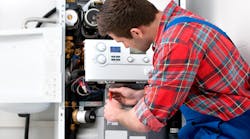Latest from Best Practices
Sponsored
Technical Foul: Simple Steps for Smoother Repairs and Installations
By John Monaghan
As plumbing and heating contractors catch their breath after a busy winter, many will now turn their attention to installation and repair to ward off any emergencies during the next cold snap.
Even the most experienced technicians, however, can make mistakes. Those errors, big or small, can result in having to make a return call to fix the issue. They might also lead to an unhappy client.
There can be any number of missteps, and contractors should not overlook some important steps in the installation, repair and maintenance of HVAC equipment. Similarly, there are considerations that all contractors must know. Follow this game plan and you will be on your way to a successful and speedy installation.
Things to Avoid
Skipping the troubleshooting stage. In an instant gratification society, there is often a rush to get to the good stuff. A long-distance runner, for instance, wants to get to the final mile of a marathon. The problem is there are 25 more before it. The same is true with plumbing contractors. You can’t get to the finish line without doing your homework to even get to the starting line.
Focusing on just one assumed or potential problem could derail you from solving the actual issue. We have all been in this situation believing “It has to be the control” or “The flame sensor must be bad.” It’s common to throw parts at a problem instead of diagnostic tools and troubleshooting. Taking the time to troubleshoot is a necessary and important step. It often saves time and prevents having to make a follow-up call a day or two later.
Ignoring the manual. This is more important today than ever before. Each piece of equipment has a slightly different series of operations. For example, some use 10K sensors while others use 12K sensors. Take the time to go through the Installation and Operations manuals and the troubleshooting guide for a more complete understanding of the equipment you’re working on. Even if the product is relatively new, consult the manual. Change is constant. Homeowners might be able to stuff the manual in a nearby hiding place and ignore it. Contractors can’t.
Failure to understand combustion safety. This goes for both atmospheric and forced draft (sealed combustion/high efficiency). For the equipment to work properly and be trouble-free it needs to run correctly. It is one of the most important concepts to know inside and out, both for safety and efficiency reasons.
For proper combustion we need the correct amount of air and fuel. We can test and adjust the combustion on all equipment, and it is especially important on high efficiency equipment. Another part of the combustion process is fresh air/make up air. For the “sealed” combustion equipment it is important to have our air intake piped to the outside of the home.
Skipping a heat loss or connected load when replacing equipment. This is one of the biggest mistakes we can make in our industry. Over-sizing of equipment is just as bad, if not worse, than under-sizing the equipment.
In this case, bigger is not better. Over-sizing can and will increase the number of cycles (short cycling) the unit will experience, resulting in premature component failures, increased repair and maintenance costs as well as higher fuel usage. That’s one sure way to lose a potential lifetime customer.
Take the time and do a heat loss, whether it be a full manual J calculation or a simple block load, it will tell you the size of the equipment needed to heat the space.
Deciding not to call for help. Manufacturers have a technical services department that know the equipment inside and out. Their personnel are trained to solve problems and know the fastest ways to get the equipment fixed and running again. Calling does not mean you do not know what you are doing. It means you value both you and your client’s time. With today’s communication technology, where you can call from almost anywhere without punching in a number, it’s easier than ever to speak with a manufacturer’s representative and quickly resolve the problem.
Must-Know
How to read and use a multimeter. This is arguably the most important thing to know in the world of HVAC. Most problems with equipment are related to failure of electrical components. Understanding how to properly use your multimeter is key. There are a lot of multimeters on the market, and even more resources on how to read them. In this business, it’s a fundamental skill that everyone must know.
How to follow and understand a wiring diagram. This goes hand-in-hand with the multimeter and shows where the wires go and what the switches and relays do. Most wiring diagrams for heating units are fairly uncomplicated. A quick review of the diagram before starting the project is always a good idea. There may be times a diagram is not readily available. A quick scan to visually locate connections and knowing what they are can ward off issues.
How to use a manometer. Your manometer is a tool that is used to test gas pressure, but it can also be used to test pressure and vacuum switches on equipment. We frequently replace those switches and still have the same problem.
By using the manometer, we can see the vacuum draw or the pressure applied to the switch. If it is below the rating listed on the switch, that typically indicates it is not the switch. The same goes for gas pressures. Modern equipment pieces have a minimum gas pressure (i.e. natural gas is usually around 5IWC). If the pressure is dropping well below that and there are repeated ignition failures and flame signal errors, check the gas pressure. Often it is a failed or failing regulator.
When to offer replacement over repair. This is usually a tough conversation, so you want to be confident about what you are recommending. As techs, we want to fix everything, and often pride ourselves on the ability to do so.
However, there are times the cost of the repair outweighs the cost of replacing the equipment, and repair would not be in the client’s best interest. We should be ready to provide both to the client in those cases.
No two jobs are ever the same. In one project, some of these concepts might not be important. The next day, a different project could present an entire set of challenges. Be prepared, work efficiently and approach every job as if there are going to be complications. If there are none, but you are still prepared for them, you can move along to the next one that much faster.
John Monaghan is the National Training Director for Ariston USA.


